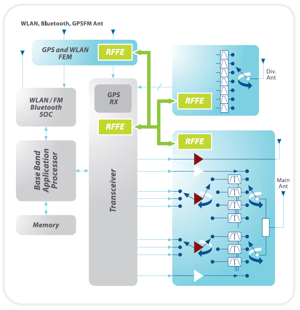MIPI RFFE™
MIPI RF Front-End Control Interface
.png?width=1800&height=900&name=Banner%20Images%20-%20MIPI%20(15).png)
Developed by: RF Front-End Control Working Group
A control interface that simplifies integration of complex RF front-end devices
Quick Facts
-
Fundamental Features
- High performance (up to 52 MHz bus speed)
- Low power
- Low EMI
- Point to multi-point
-
Use Cases
- 5G/LTE-A
- MIMO
- Carrier aggregation uplink/downlink
- WiFi/Bluetooth
-
Physical Layer
CMOS Single-Ended I/Os (1.2V and 1.8V), employing hysteresis on inputs
Get the Specification
-
Current Version
MIPI RFFE℠ v3.1 (April 2023)
Member version
-
App Note & FAQs
-
Previous Versions
All RFFE versions are available to MIPI members on the member website (Causeway).
Overview
General Info
-
Overview
Originally released in July 2010, the MIPI RF Front End Control Interface, MIPI RFFESM, is the world’s de facto standard interface for control of radio frequency (RF) front-end (FE) subsystems. It delivers fast, agile, semi-automated and comprehensive control of the complex RF subsystem environment, which has rigorous performance requirements and can include up to 19 components per bus instance (up to 15 >subordinate devices and up to four main devices), including power amplifiers, LNAs, antenna tuners, filters and switches.
The interface can be applied to the full range of RF front-end components to simplify product design, configuration and integration, and to facilitate interoperability of components supplied by different vendors. The conveniences make it easier for RF device vendors, baseband and transceiver vendors and mobile OEMs to address end-user needs for faster data speeds and better call quality and to develop scalable solutions and expedite time to market for new designs in the mobile, automotive, industrial and Internet of Things (IoT) sectors.
MIPI RFFE is developed by the MIPI RF Front-End Control Working Group. The current release, v3.1, was released in 2023.
The specification is available only to MIPI Alliance members. For information about joining MIPI Alliance, visit Join MIPI.
-
Key Features
RFFE is a two-wire interface that uses unterminated, single-ended CMOS I/Os for lower power. It can be used with a broad range of bus operating frequencies and features synchronous read capability, multi-main configuration, support for carrier aggregation and the use of multiple transceivers, dual-SIM designs and reserved registers that improve the efficiency of hardware and software development.
-
Latest Release
The current release, version v3.1, clarifies the descriptions of a number of items, including: NRF, SCLKs, Bus Diameter, and Operational Modes. In addition, the MIPI-deprecated technical terms “master” and “slave” have been replaced throughout the document with “main” and “subordinate,” respectively.
MIPI RFFE v3.0 was designed to deliver the tighter timing precision and reduced latencies needed to advance 5G rollout around the world. The specification streamlines and optimizes the interface to enable more rapid and dynamic configuration changes within and across RFFE subsystems and deliver the specific capabilities necessary for the Frequency Range 1 (FR1) of traditional sub-6 GHz cellular bands.
RF bands for uplink and downlink communications have multiplied in 5G, and subcarrier spacing (SCS) windows among RF packets have narrowed. MIPI RFFE v3.0 addresses these requirements of the 3GPP 5G standard by delivering enhanced triggering features and functionality for synchronizing and scheduling changes in register settings, either within a slave device or across multiple devices:
- Timed triggers—Allow for tighter, synchronized timing control of multiple carrier aggregation configurations
- Mappable triggers—Enable groups of control functions to be remapped
- Extended triggers—Boost the number of unique triggers available in the RF control system and accommodate increasingly complex radio architectures
MIPI RFFE improves throughput efficiencies and reduces packet latency, while also improving the precision in trigger placement. For back-to-back triggering operations, for example, v3.0 delivers a 20x improvement in timing precision. -
Diagrams & Tables







